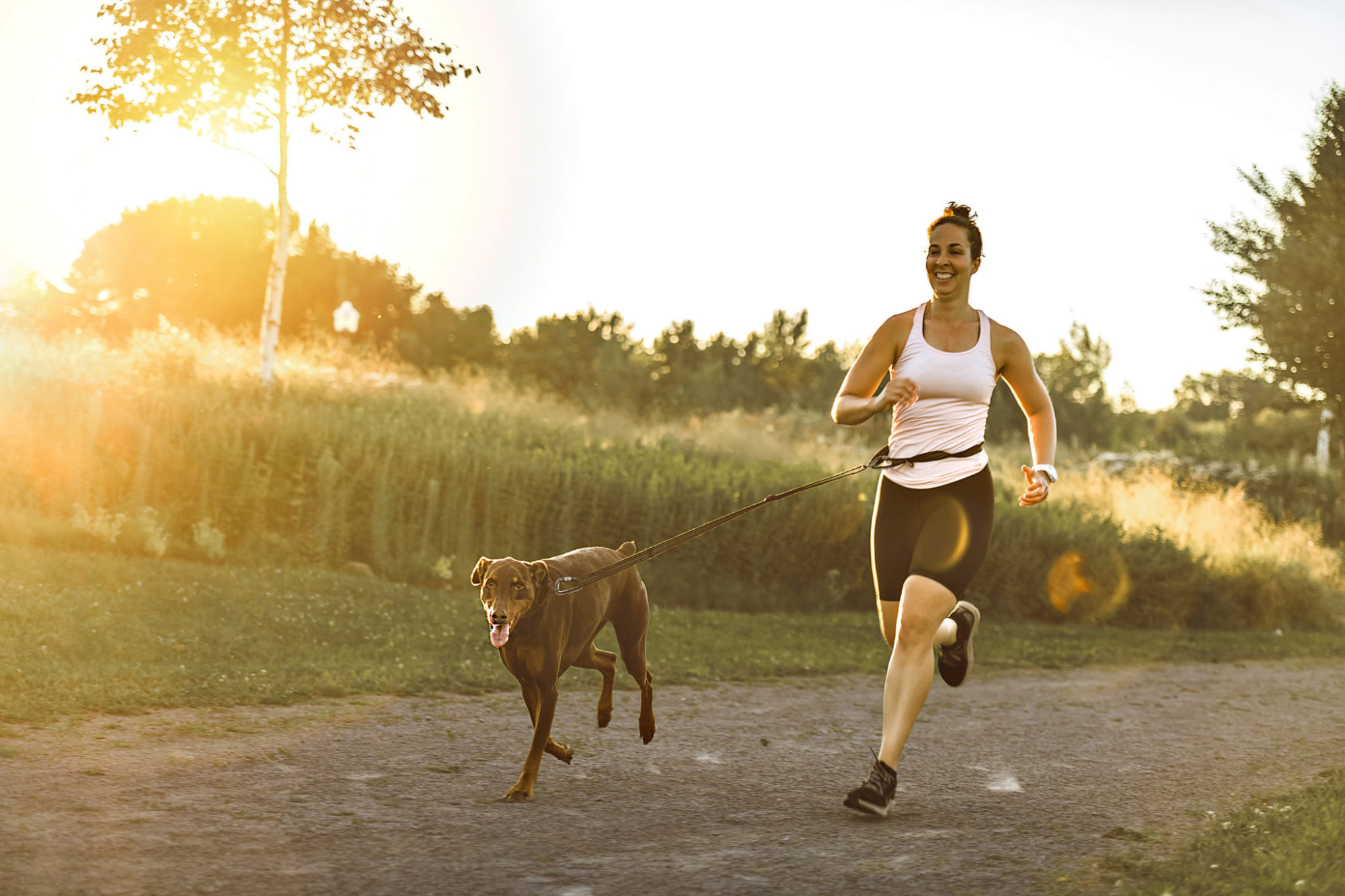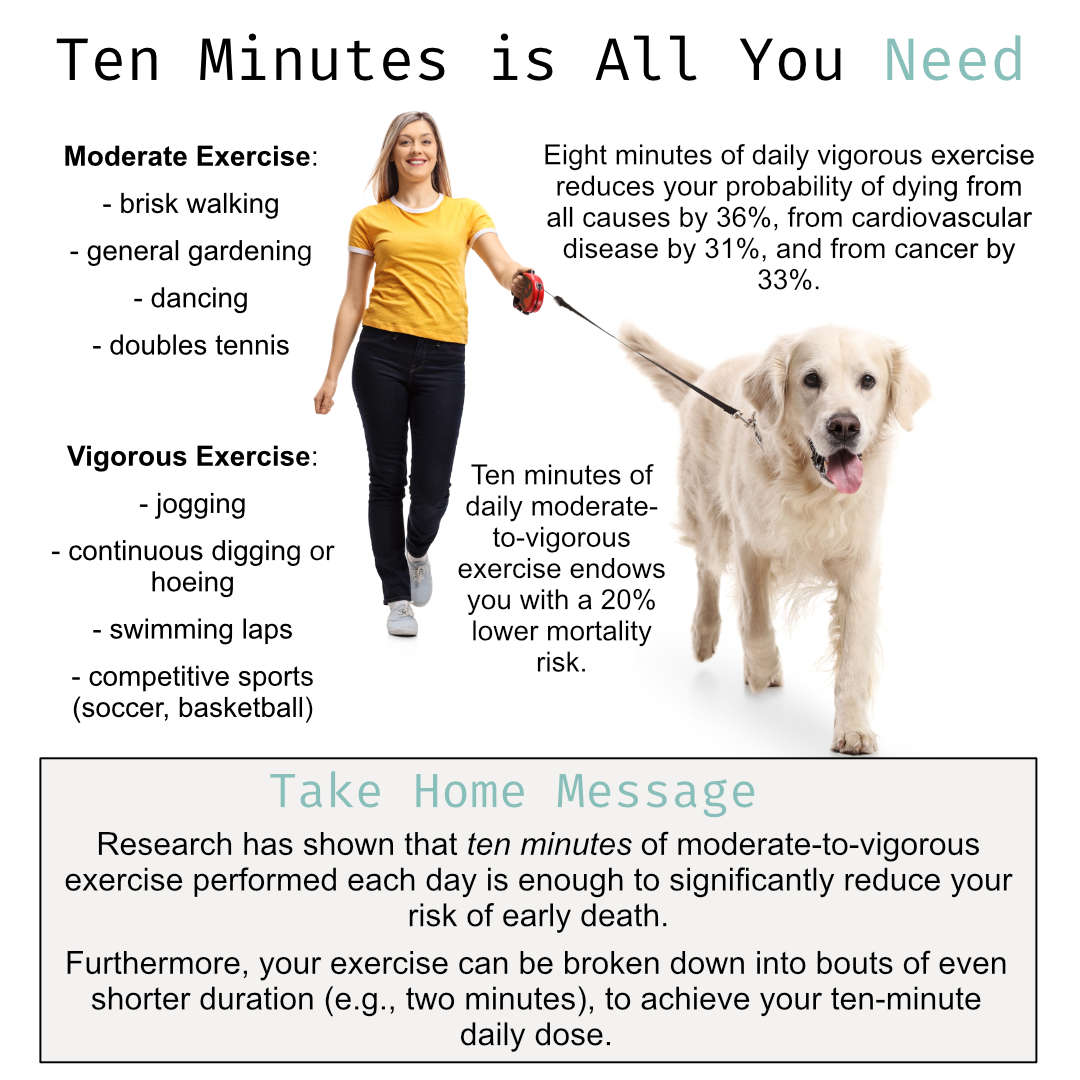Ten Minutes is All You Need

“Success is the sum of small efforts, repeated day in and day out.”
Robert Collier
Executive Summary
The aim of this article is to help busy people increase their lifespan by using short bouts of regular exercise.
Crucially, research has shown that ten minutes of moderate-to-vigorous exercise performed each day is enough to significantly reduce your risk of early death.
Furthermore, your exercise can be broken down into bouts of even shorter duration (e.g., two minutes), to achieve your daily ten-minute dose.
Introduction
We all know that exercising is good for us, but too many people lack the time to exercise regularly.
For example, working mothers find it particularly challenging to meet current exercise guidelines of 20-30 minutes of daily exercise, given their commitments to raising children while simultaneously pursuing demanding careers 1.
Indeed, many people who are juggling work, study, and family, have neither the time nor the energy to spare for lengthy exercise regimes.
But what if you could get almost all the longevity benefits of exercise in just ten minutes a day?
First, what is moderate-to-vigorous activity?
Before we go any further, let’s define exactly what I mean by moderate and vigorous exercise.
Below, I’ve compiled a table with some relatable examples of physical activities to help you clearly understand the exercise zones we are talking about.
| Moderate Intensity | Approx MET Score | Vigorous Intensity | Approx MET Score |
|---|---|---|---|
| Brisk Walking | 4.3 | Running or jogging | 8.3 |
| General gardening (raking, weeding, etc.) | 3.8 | Swimming laps, freestyle, training hard | 9.8 |
| Dancing | 3.5 | Singles tennis | 8.0 |
| Cycling at a regular pace | 4.0 | Aerobics or cardio kickboxing | 7.8 |
| Doubles Tennis | 6.0 | Cycling 10 miles per hour or faster | 6.8 |
| Water aerobics | 5.5 | Jumping rope | 11 |
| Canoeing at <4 mph | 4.0 | Hiking uphill or with a heavy backpack | 7.3 |
| Volleyball (non-competitive) | 4.0 | High-intensity interval training (HIIT) | 8-12+ |
| General house cleaning | 3.3 | Competitive sports (basketball, football, soccer) | 10 |
| Mowing the lawn with a push mower | 4.5 | Heavy, fast-paced gardening (continuous digging or hoeing) | 7.8 |
How much exercise do you need to do to improve your health?
For those who want to maximize their health but have very limited time to train, defining the minimal effective exercise dose is of utmost importance.
Fortunately for us, researchers have now answered this critical question.
For example, Hupin and Colleagues pooled the data from nine independent studies that collectively included a total of 122,417 participants aged 60 years and above. Crucially, they found that as little as 10 minutes of moderate-to-vigorous exercise each day led to a 22% reduction in mortality for adults (RR=0.78 (95% CI 0.71 to 0.87) p<0.0001) 2.
And in an independent study, Arem and Colleagues also found that 10 minutes of daily moderate to vigorous exercise endows you with a 20% lower mortality risk (see Figure One) 3.

Are ten minutes really enough?
But maybe you think that this sounds too good to be true. I mean, can exercising for a mere 10 minutes a day really decrease your chance of dying young?
Well, recent studies consistently say yes.
First, a study of 116,221 US adults revealed that adults performing 10–59 minutes of exercise per week have an 18% lower risk of all-cause mortality (hazard ratio (HR): 0.82, 95% confidence interval (CI): 0.72–0.95) 4.
Second, when analyzing a cohort of 210,327 Taiwanese adults, Martinez-Gomez and Colleagues showed that around 10 minutes a day of moderate-to-vigorous exercise reduced mortality risk by about 36% 5.
Finally, Grandes and Colleagues showed that even 50 minutes a week (less than 10 minutes a day!) of moderate exercise was enough to reduce the mortality risk of primary care patients by 31% 6!
Thus, the answer is clear. Even exercising for as little as 10 minutes per day significantly reduces your chance of dying young!
Train harder, not longer, for maximal benefit.
While the studies summarized above all show that as little as ten minutes of daily exercise improves your health, they also found that twenty-to-thirty minutes of moderate-to-vigorous exercise is the optimal dose for decreasing your mortality risk (e.g., see Figure One) 2,3.
However, this begs the question: Could training harder reduce the training time required for optimal longevity and health?
The answer is a resounding yes!
In a landmark research paper, Stamatakis and Colleagues discovered that short bursts of vigorous physical activity of a duration of 4.4 min per day are associated with a 26%–30% reduction in all-cause and cancer mortality risk and a 32%–34% reduction in CVD mortality risk 7!
Then in a complementary study, the same research group went on to characterize the optimal dose of vigorous physical activity for long-term survival 8. Strikingly, they found that around 55 minutes of vigorous physical activity per week (which is about eight minutes per day), reduces your probability of dying from all causes by about 36%, from cardiovascular disease by 31%, and from cancer by 33% 8!
In summary, engaging in very short (10 minutes or less) daily bouts of vigorous exercise significantly improves your chances of living a long and healthy life!
Thus if you train harder, you can train shorter!
Stacking the Deck: How Shorts Bouts of Exercise Add Up
The final piece of good news is that short bouts of activity add up over the day.
In other words, five two-minute bouts of exercise spread over the course of your day is equivalent to one ten-minute exercise bout with respect to protecting you from an early grave 7,9.
The ability to stagger your workload across the day provides incredible flexibility for the time-poor when designing exercise programs.
For example, a 10-minute workout performed at high intensity may seem daunting and unpleasant. However, knowing that you can break up an arduous 10-minute grind into two-minute bursts, with rest breaks in between each bout (i.e., by using a classic interval training approach), means that regularly performing vigorous exercise is so much more achievable.
Alternatively, you can perform one 5-minute round in the morning and one in the evening, which may be more convenient (and more palatable!) for those just starting out their exercise journey.
Whatever your preferred approach may be, the bottom line is that you can use very short bouts of exercise to achieve your daily 10-minute dose of vigorous physical activity.
Design and implementation of ten-minute workouts.
Let’s keep things simple. Here, I’m assuming the straightforward goal of shifting from being inactive to performing 5-7 ten-minute workouts per week, week in week out, month in month out, year in year out, with:
1. No or minimal equipment.
2. No significant disruption to your established routine.
3. No personal trainers.
4. No joining weird fitness cults.
5. No bizarre, hard-to-learn, boutique exercises.
Phase One: Start Walking Towards a Healthier You
Get Ready to Walk: You don’t need fancy equipment or a gym membership to take the first step towards better health. All you need is 10 minutes a day.
How to Do It: Schedule 10 minutes in your day and go for a brisk walk. It can be done in one ten-minute chunk or two five-minute chunks. It’s that simple. Repeat 5-7 times a week.
Why It Works: A brisk walk may seem like a small effort, but research shows that this simple task can reduce your chance of premature death by 20% 2,3! Imagine gaining more years to your life just by enjoying a daily walk.
Phase Two: Transition to Jogging
Brisk walking is a moderate-intensity activity, and we know that vigorous exercise is best for preventing death. So, the next phase involves gradually increasing your exercise intensity.
Get Ready to Run: The simplest way to increase your intensity is to start adding some slow jogs to your walk. For example, you could jog for the last hundred meters of your walk. Then, when that becomes easy, the last 200 meters, then the last 300 meters, and so on.
Alternatively, you could walk a minute, jog for 20 seconds, walk a minute, etc. Over time, gradually increase the time spent jogging time and reduce the time spent walking.
Please note that physiological adaptation is slow, and training for only 10 minutes a day is the minimum volume required to induce biological adaptation, so take your sweet time when transitioning from walking to running.
Why it Works: Jogging is a vigorous exercise, and research shows that 8-10 minutes of daily vigorous exercise can decrease your chance of premature death by 36% 7,8.
A Word of Warning: At some point, you’re going to be able to run for the entire 10 minutes. This puts you at a slight risk of injury if you don’t warm up before you start jogging. To avoid injury, you can either (a) add an extra minute or two at the start to warm up, or (b) incorporate your warm-up into your ten-minute workout.
If you choose option (b), start with a one-minute brisk walk, followed by a minute of easy jogging, and then transition to your full working intensity. This way, you’ll still be getting a solid eight minutes of vigorous exercise, plus two minutes of moderate-to-vigorous exercise each workout. And that’s great!
Phase Three: Jump Rope
How to Do It: The best way to begin jumping rope is to use it as a form of interval training. For example, you could start out doing 4-5 sets of 20 seconds of skipping, and forty seconds of rest. As you become conditioned to skipping, increase your work intervals, reduce your rest intervals, and then add more sets.
Why it Works: I like jump rope as an exercise for several reasons.
First and foremost, it’s a superb conditioning tool. As you can see from Table One, jump rope is a vigorous exercise (with a MET score of 11 no less!), which means that you only need 8-10 minutes of daily jump rope to maximize your health 7,8.
Second, jump rope is great for improving your cardiovascular fitness, your coordination, your jumping ability, your sprinting ability, and your bone density 10-12, which is why skipping has remained a staple exercise for boxers and combat athletes the world over!
Third, all you need is a skipping rope and some space to skip. As skipping can easily be performed indoors, you can do it no matter what the weather (unlike walking and running). Furthermore, it’s a safe option for women and shift workers, because you don’t have to go outside and put yourself at unnecessary risk.
Finally, as a skipping rope can be packed into even the smallest travel bag, you’ll always have access to your gym no matter how much you travel!
A Word of Warning: Be aware that when you first begin skipping, jumping rope is absolutely brutal on your calves. So, start easy, give yourself time to recover between sessions, progress slowly, and be consistent.
Finally, Consider Improving Your Diet
In this article, I’ve sung the praise of short workouts to optimize your health. And while it’s clear that performing consistent ten-minute workouts will certainly improve your health and longevity, note that ten minutes is the absolute minimum effective exercise volume for eliciting physiological change.
Because of this, improving your body composition using ten-minute workouts without changing your diet will be extremely difficult. And if like me you’re on the wrong side of fifty, forget about it!
Alas, the harsh reality is that improving your body composition is best accomplished through a combination of diet and exercise.
Now, as far as diets go, I recommend either the MIND diet or the Mediterranean Diet, as both have proven health benefits over and above weight loss. However, you could also consider time-restricted feeding as a convenient approach to enter a slight calorie deficit and safely shed some unwanted weight.
Truth be told, I’m not a big fan of preaching about diets. My only firm suggestion is to take your time. Pick a diet that sounds delicious and fits your lifestyle, Google calorie regimes on how to lose weight, and go with the most conservative weight loss approach that the algorithm recommends.
The important point is to consistently exercise, eat healthy, and be happy.
Take Home Message
Exercising for a mere ten minutes a day is a proven way to reduce your chances of dying young. Moreover, if you’re willing to put in a bit of work and train hard, you will enjoy significant protection from all-cause mortality, cancer, and cardiovascular disease.
You don’t need a gym. You don’t need a personal trainer. And you don’t need fancy equipment. Walking, jogging, and skipping are three simple and effective approaches that get the job done.
All you need is ten minutes.

Acknowledgments
Images created by Ljupco and LSOphoto
References and Further Reading
1 Limbers, C. A., McCollum, C., Ylitalo, K. R. & Hebl, M. Physical activity in working mothers: Running low impacts quality of life. Womens Health (Lond) 16, 1745506520929165, doi:10.1177/1745506520929165 (2020).
2 Hupin, D. et al. Even a low-dose of moderate-to-vigorous physical activity reduces mortality by 22% in adults aged ≥60 years: a systematic review and meta-analysis. Br J Sports Med 49, 1262-1267, doi:10.1136/bjsports-2014-094306 (2015).
3 Arem, H. et al. Leisure time physical activity and mortality: a detailed pooled analysis of the dose-response relationship. JAMA Intern Med 175, 959-967, doi:10.1001/jamainternmed.2015.0533 (2015).
4 Zhao, M., Veeranki, S. P., Li, S., Steffen, L. M. & Xi, B. Beneficial associations of low and large doses of leisure time physical activity with all-cause, cardiovascular disease and cancer mortality: a national cohort study of 88,140 US adults. Br J Sports Med 53, 1405-1411, doi:10.1136/bjsports-2018-099254 (2019).
5 Martinez-Gomez, D. et al. Long-term leisure-time physical activity and risk of all-cause and cardiovascular mortality: dose-response associations in a prospective cohort study of 210 327 Taiwanese adults. Br J Sports Med 56, 919-926, doi:10.1136/bjsports-2021-104961 (2022).
6 Grandes, G. et al. Any increment in physical activity reduces mortality risk of physically inactive patients: prospective cohort study in primary care. Br J Gen Pract 73, e52-e58, doi:10.3399/bjgp.2022.0118 (2023).
7 Stamatakis, E. et al. Association of wearable device-measured vigorous intermittent lifestyle physical activity with mortality. Nat Med 28, 2521-2529, doi:10.1038/s41591-022-02100-x (2022).
8 Ahmadi, M. N. et al. Vigorous physical activity, incident heart disease, and cancer: how little is enough? Eur Heart J 43, 4801-4814, doi:10.1093/eurheartj/ehac572 (2022).
9 Millard, L. A. C., Tilling, K., Gaunt, T. R., Carslake, D. & Lawlor, D. A. Association of physical activity intensity and bout length with mortality: An observational study of 79,503 UK Biobank participants. PLoS Med 18, e1003757, doi:10.1371/journal.pmed.1003757 (2021).
10 García-Pinillos, F., Lago-Fuentes, C., Latorre-Román, P. A., Pantoja-Vallejo, A. & Ramirez-Campillo, R. Jump-Rope Training: Improved 3-km Time-Trial Performance in Endurance Runners via Enhanced Lower-Limb Reactivity and Foot-Arch Stiffness. Int J Sports Physiol Perform, 1-7, doi:10.1123/ijspp.2019-0529 (2020).
11 Singh, U. et al. Jump rope training effects on health- and sport-related physical fitness in young participants: A systematic review with meta-analysis. J Sports Sci 40, 1801-1814, doi:10.1080/02640414.2022.2099161 (2022).
12 Bae, S. et al. Position Statement: Exercise Guidelines for Osteoporosis Management and Fall Prevention in Osteoporosis Patients. J Bone Metab 30, 149-165, doi:10.11005/jbm.2023.30.2.149 (2023).

Ten Minutes is All You Need
Research has shown that ten minutes of moderate-to-vigorous exercise performed each day is enough to significantly reduce your risk of early death.

Dogs Make Kids More Resilient
New research demonstrates the positive role dogs have on the social and emotional development of children aged 2-5 years.




